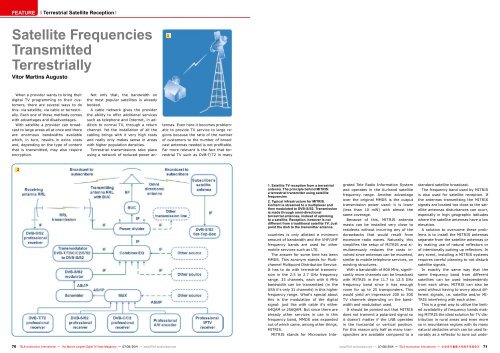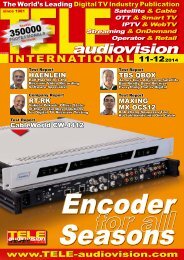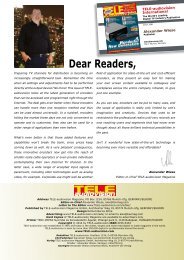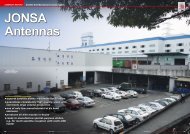ROKS MITRIS
Create successful ePaper yourself
Turn your PDF publications into a flip-book with our unique Google optimized e-Paper software.
FEATURE<br />
Terrestrial Satellite Reception<br />
Satellite Frequencies<br />
Transmitted<br />
Terrestrially<br />
Vitor Martins Augusto<br />
1<br />
When a provider wants to bring their<br />
digital TV programming to their customers,<br />
there are several ways to do<br />
this: via satellite, via cable or terrestrially.<br />
Each one of these methods comes<br />
with advantages and disadvantages.<br />
With satellite a provider can broadcast<br />
to large areas all at once and there<br />
are enormous bandwidths available<br />
which, in turn, results in extra costs<br />
and, depending on the type of content<br />
that is transmitted, may also require<br />
encryption.<br />
Not only that, the bandwidth on<br />
the most popular satellites is already<br />
booked.<br />
A cable network gives the provider<br />
the ability to offer additional services<br />
such as telephone and Internet, in addition<br />
to normal TV, through a return<br />
channel. Yet the installation of all the<br />
cabling brings with it very high costs<br />
and really only makes sense in areas<br />
with higher population densities.<br />
Terrestrial transmissions take place<br />
using a network of reduced-power antennas.<br />
Even here it becomes problematic<br />
to provide TV service to large regions<br />
because the ratio of the number<br />
of customers to the number of broadcast<br />
antennas needed is not profitable.<br />
Far more relevant is the fact that terrestrial<br />
TV such as DVB-T/T2 in many<br />
2<br />
1. Satellite TV reception from a terrestrial<br />
antenna. The principle behind <strong>MITRIS</strong>:<br />
a terrestrial transmitter using satellite<br />
frequencies<br />
2. Typical infrastructure for <strong>MITRIS</strong>.<br />
Content is streamed to a multiplexer and<br />
then modulated to DVB-S/S2. Transmission<br />
is made through omni-directional<br />
terrestrial antennas, instead of uplinking<br />
to a satellite. Reception, however is not<br />
different from a traditional satellite TV. Just<br />
point the dish to the transmitter antenna.<br />
countries is only allotted a minimum<br />
amount of bandwidth and the VHF/UHF<br />
frequency bands are used for other<br />
mobile services such as LTE.<br />
The answer for some time has been<br />
MMDS. This acronym stands for Multichannel<br />
Multipoint Distribution Service.<br />
It has to do with terrestrial transmission<br />
in the 2.5 to 2.7 GHz frequency<br />
range. 33 channels, each with 6 MHz<br />
bandwidth can be transmitted (in the<br />
USA it‘s only 31 channels) in this higher<br />
frequency range. What‘s special about<br />
this is the modulation of the digital<br />
signal: just like with cable it‘s either<br />
64QAM or 256QAM. But since there are<br />
already other services in use in this<br />
frequency band, MMDS was expanded<br />
out of which came, among other things,<br />
<strong>MITRIS</strong>.<br />
<strong>MITRIS</strong> stands for Microwave Inte-<br />
standard satellite broadcast.<br />
The frequency band used by <strong>MITRIS</strong><br />
is also used for satellite reception. If<br />
the antennas transmitting the <strong>MITRIS</strong><br />
signals are located too close to the satellite<br />
antennas disturbances can ocurr,<br />
especially in high geographic latitudes<br />
where the satellite antennas have a low<br />
elevation.<br />
A solution to overcome these problems<br />
is to install the <strong>MITRIS</strong> antennas<br />
separate from the satellite antennas or<br />
by making use of natural reflectors or<br />
of intentionally putting up reflectors. In<br />
any event, installing a <strong>MITRIS</strong> systems<br />
requires careful planning to not disturb<br />
satellite signals.<br />
In exactly the same way that the<br />
same frequency band from different<br />
satellites can be used independently<br />
from each other, <strong>MITRIS</strong> can also be<br />
used without having to worry about different<br />
signals, i.e. satellite and/or MI-<br />
TRIS interfering with each other.<br />
This is a great way to utilize the limited<br />
availability of frequency bands making<br />
<strong>MITRIS</strong> the ideal solution for TV distribution<br />
in rural areas and even more<br />
so in mountaines regions with its many<br />
natural obstacles which can be used favorably<br />
as a reflector to tune out undegrated<br />
Tele Radio Information System<br />
and operates in the Ku-band satellite<br />
frequency range. Another advantage<br />
over the original MMDS is the output<br />
transmission power used: it is lower<br />
(less than 10 mW) with almost the<br />
same coverage.<br />
Because of this, <strong>MITRIS</strong> antenna<br />
masts can be installed very close to<br />
residents without incurring any of the<br />
dxrawbacks that would result from<br />
excessive radio waves. Naturally, this<br />
simplifies the setup of <strong>MITRIS</strong> and simultaneously<br />
reduces the costs involved<br />
since antennas can be mounted,<br />
similar to mobile telephone services, on<br />
existing structures.<br />
With a bandwidth of 800 MHz, significantly<br />
more channels can be broadcast<br />
with <strong>MITRIS</strong> in the 11.7 to 12.5 GHz<br />
frequency band since it has enough<br />
room for up to 25 transponders. This<br />
would yield an impressive 200 to 300<br />
TV channels depending on the bandwidth<br />
and modulation used.<br />
It should be pointed out that <strong>MITRIS</strong><br />
does not transmit a polarized signal so<br />
it doesn‘t matter if the LNB operates<br />
in the horizontal or vertical position.<br />
For this reason only half as many transponders<br />
are available compared to a<br />
70 TELE-audiovision International — The World‘s Largest Digital TV Trade Magazine — 07-08/2014 — www.TELE-audiovision.com<br />
www.TELE-audiovision.com — 07-08/2014 — TELE-audiovision International — 全 球 发 行 量 最 大 的 数 字 电 视 杂 志 71


















